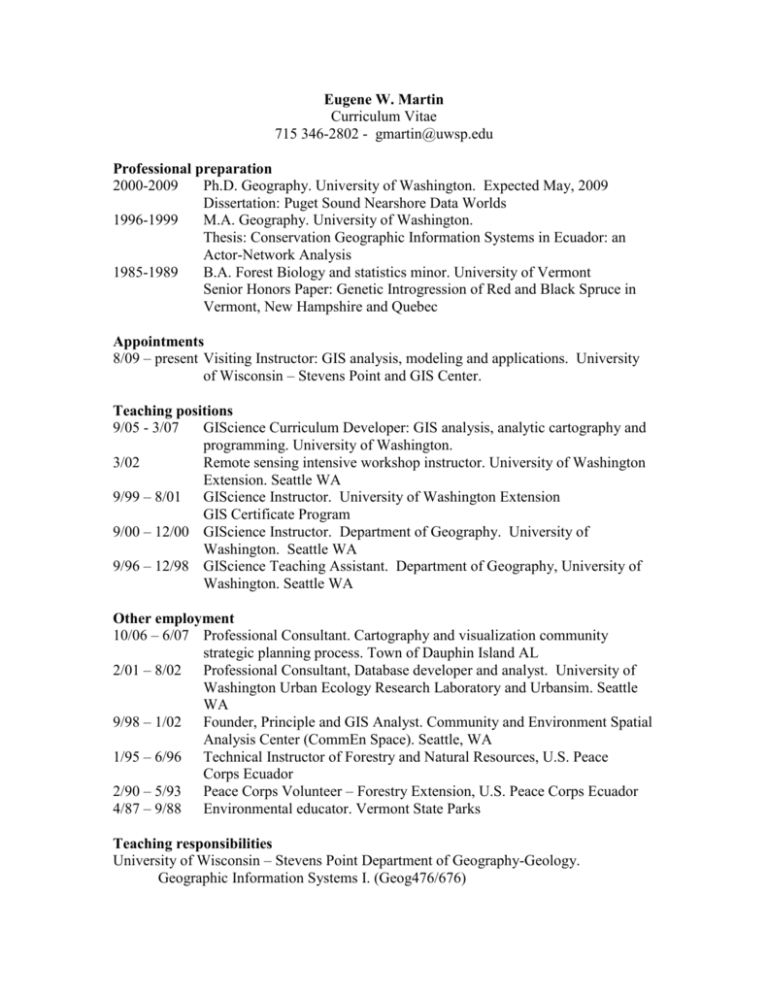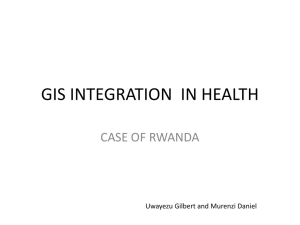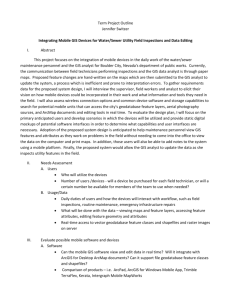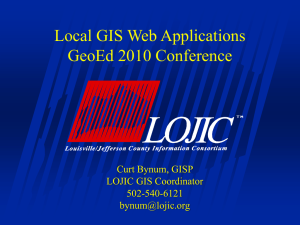E. Martin and C. Davis, 2001. Geographic Information and Spatial
advertisement

Eugene W. Martin Curriculum Vitae 715 346-2802 - gmartin@uwsp.edu Professional preparation 2000-2009 Ph.D. Geography. University of Washington. Expected May, 2009 Dissertation: Puget Sound Nearshore Data Worlds 1996-1999 M.A. Geography. University of Washington. Thesis: Conservation Geographic Information Systems in Ecuador: an Actor-Network Analysis 1985-1989 B.A. Forest Biology and statistics minor. University of Vermont Senior Honors Paper: Genetic Introgression of Red and Black Spruce in Vermont, New Hampshire and Quebec Appointments 8/09 – present Visiting Instructor: GIS analysis, modeling and applications. University of Wisconsin – Stevens Point and GIS Center. Teaching positions 9/05 - 3/07 GIScience Curriculum Developer: GIS analysis, analytic cartography and programming. University of Washington. 3/02 Remote sensing intensive workshop instructor. University of Washington Extension. Seattle WA 9/99 – 8/01 GIScience Instructor. University of Washington Extension GIS Certificate Program 9/00 – 12/00 GIScience Instructor. Department of Geography. University of Washington. Seattle WA 9/96 – 12/98 GIScience Teaching Assistant. Department of Geography, University of Washington. Seattle WA Other employment 10/06 – 6/07 Professional Consultant. Cartography and visualization community strategic planning process. Town of Dauphin Island AL 2/01 – 8/02 Professional Consultant, Database developer and analyst. University of Washington Urban Ecology Research Laboratory and Urbansim. Seattle WA 9/98 – 1/02 Founder, Principle and GIS Analyst. Community and Environment Spatial Analysis Center (CommEn Space). Seattle, WA 1/95 – 6/96 Technical Instructor of Forestry and Natural Resources, U.S. Peace Corps Ecuador 2/90 – 5/93 Peace Corps Volunteer – Forestry Extension, U.S. Peace Corps Ecuador 4/87 – 9/88 Environmental educator. Vermont State Parks Teaching responsibilities University of Wisconsin – Stevens Point Department of Geography-Geology. Geographic Information Systems I. (Geog476/676) Development and instruction: 2009 – present. Class size: 40 Develop, use and maintain a geographic-based spatial information system (GIS) for resource management. Acquire and assess spatial data. Compare raster and vector data models. Computer-based geographic data handling, analysis, interpretation, and display. Cartographic and spatial modeling. Lecture, lab exercises, and final project. University of Wisconsin – Stevens Point Department of Geography-Geology. GIS Applications in Sustainability (Geog471/671) Development and instruction: 2010 – present. Class size: 15 GIS concepts and applications to support regional and community level sustainability initiatives. Examination of spatial analysis topics and practices including sustainability indicators, resource management, public participation, decision-making and effective presentation. Lecture and lab exercises. University of Wisconsin – Stevens Point Department of Geography-Geology. GIS Applications in Sustainability (Geog481/681) Development and instruction: 2009 – present. Class size: 15 Effectively construct, integrate, design and implement geodatabases. Examine storage, cataloging, maintenance and use of geospatial data within practical applications. Lecture, lab exercises and final project. University of Washington Department of Geography Geographic Information Systems Analysis. (Geog460) Instructor 2000; teaching assistant 1996 – 2004. Class size: 100 Methods of analysis using geographic information systems. Operations on raster and vector data including map transformation, overlay, aggregation, focal statistics, cost path, surface flow, and iterative functions. Lecture, lab, and final project assignment. University of Washington. Department of Geography Coastal Geographic Information Systems (Geog462) Development and teaching assistant 2006 and 2007. Class size: 60 Combines lectures about fundamental concepts in geographic information systems with hands-on computer lab assignments about coastal environment-society issues. Coastal feature data measurement, characterization, and movement related to the land-water and environment society dynamic. University of Washington. Department of Geography Analytic Cartography and Programming (Geog465) Development and teaching assistant 2007. Class size: 40 An exploration of GIS database models, development, and management systems used in GIS. Uses programming languages most applicable to GIS database work, particularly related to extending current commercial GIS such as ArcGIS. University of Washington Extension Program. Images to Information remote sensing and GIS workshop Development and instruction 2002. 20 hours of instruction. Class size: 35 A three-day weekend course for GIS practitioners about remote sensing best practices for GIS. Topics include image display, calibration, analysis and integration with GIS. University of Washington Extension Certificate Program in GIS. GIS Analysis Design and instruction 1999-2001. Class size: 30 A three-month continuing education course for working professionals seeking to expand their work skills to include GIS. Course content includes database development, data analysis, project planning and execution. Community and Environment Spatial Analysis Center. GIS Mentorship Program Development and instruction 1999-2000. Class size: 12 Design and deliver a six-month mentor and consultant program for local community organizations’ work to implement and operate localized GIS projects. Course content includes effective cartography, responsible data reuse, practical analysis methods, participant developed projects and site visits. Funding made possible by the Bullett Foundation ($10,000) Languages spoken Spanish: fluent Refereed publications E. Martin, 2000. Actor-networks and implementation: examples from conservation GIS in Ecuador. International Journal of Geographic Information Science, 14, 715-738. E. Martin, 2000. Showing topography between the lines, Geospatial Solutions. Book chapters E. Martin, C. Davis, T. Schaub and CommEn Space. 2002. Pavement. Durning, A. T. & Northwest Environment Watch (Eds.), This Place on Earth 2002: Measuring What Matters (pp. 23-33). Seattle: Northwest Environment Watch (now Sightline). Reports/papers read or in print E. Martin, D. Munro, and R. Weeks. 2002. Images to Information Workshop: Remotely Sensed Data for GIS Applications. Workshop schedule and materials. March 8-9 and March 29-30, 2002, Seattle, WA. University of Washington Educational Outreach. E. Martin, C. Davis and CommEn Space. 2001. Atlas of targeted and acquired properties along Washington State’s Cascade Crest – 2001. The Cascades Conservation Partnership. E. Martin and C.Davis. 2000. The Pacific Northwest Conservation GIS User Assessment: Use of Geographic Information Systems (GIS) by Environmental Organizations in the Pacific Northwest. Seattle: Community and Environment Spatial Analysis Center. E. Martin. 1999. Conservation geographic information systems in Ecuador: an actornetwork analysis. Thesis. University of Washington, Seattle. E. Martin. 1998. Taking another look: Science in Action revisited (Book review) E. Martin, C. Davis and Carter-Mortimer, A. 1998. Puget Sound Basin Rapid Critical Habitat Hazard Assessment. Seattle, WA. E. Martin 1997. Visualizing common lands: A framework component of GIS in other cultures. Seattle WA. E. Martin 1997. Nonpoint water pollution and land use change: Detecting a control policy in the Puget Sound region with Spectral Ratios and Spectral Mixing. Seattle, WA. E. Martin, C. Davis, & CommEn Space. 2001. Muckleshoot Indian Tribe Chinook Recovery Plan Watershed Assessment. E. Martin. 2000. Measurement of Impervious Surfaces with Spectral Mixture Analysis and Landsat TM Data. Invited presentations Representation of indigenous interests and values in spatial data. Panel on GIS and Indigenous People. Meetings of the AAG, Denver CO, 2005 Conference presentations Knowledge production GIS. Abstract submitted and accepted for Meetings of the Association of American Geographers. Seattle WA., 2011. Data sharing, order, and heterogeneous GIS. Abstract submitted and accepted for Meetings of the Association of American Geographers. Washington D.C., 2010. Data Worlds of Puget Sounds nearshore environment. Abstract submitted and accepted for Meetings of the Association of American Geographers. Las Vegas NV, 2009. Data communities. Meetings of the Association of American Geographers, Denver CO, 2005. Data communities and data effects. Society for Conservation GIS Annual Conference, Monterey CA, 2003 Eugene Martin and CommEn Space. Monitoring Sprawl. Annual URISA Conference Washington State Chapter, Seattle WA, 2002 Eugene Martin and CommEn Space. Geographic information from images. Annual URISA Conference Washington State Chapter, Seattle WA, 2001 Janice Thomson and Eugene. Martin. Conservation Geographic Information Systems and Cartography. Grow Smart Washington, Seattle WA, October 6, 2001 Setting things straight: smoothing algorithms to post process GPS line data. Society for Conservation GIS Annual Conference, Borrego Springs CA, 2001. E. Martin and C. Davis. ‘Fast Map’: A GIS database and interface for parcel evaluation. Land Trust Alliance PNW Rally, Leavenworth WA. 2001 E. Martin and C. Davis, 2001. Geographic Information and Spatial Analyses for the Muckleshoot Indian Tribe's Cedar River Chinook Recovery Plan. Pacific Salmon Information Network, Seattle WA, February 1, 2001 Watershed Impervious Surface Assessment Using Spectral Mixing Analysis. Society for Conservation GIS Annual Conference, Borrego Springs CA, 2000 Contracts and grants February 2011 – February 2012. UWSP Student and Employee Sustainable Transportation Costs: Assessment, Awareness and Decision Support. Wisconsin Institute for Sustainable Technologies Scholar Program and UWSP GIS Center. $35,000 October 2006 – June 2007. Cartography and visualization for community sustainability planning. Town of Dauphin Island AL, $16,000 May 1999 – September 2003. Fifty-three months of no-charge nonprofit office suite in Seattle’s central business district (900 sq. ft.). Bank of America. $47,700. January 2001 – June 2001. Impervious surfaces and population density change 19902000 in Seattle WA, Portland OR, and Vancouver BC. E. Martin, C. Davis and CommEn Space. Northwest Environment Watch (now Sightline). $12,000 March 2001 GIS hardware and software grant. Six licenses ArcView 3.3 and all extentions; Site license (three seats) ArcGIS and all extensions. Environmental Systems Research Institute Conservation Program. $54,000 (estimated value) February-April, 2000. Landsat TM spectral mixing analysis of impervious surface and land cover data development Pierce County, Washington. Parametrix, $5,400. February-December, 2000. GIS for land trusts in the Pacific Northwest. E. Martin, C. Davis and CommEn Space. Terra Foundation Inc. Longmont CO, $12,500. Second award, $23,000. May-July, 2000. CommEn Space GIS Mentorship Program. E. Martin and CommEn Space. Bullitt Foundation, $6,000 August, 2000. Trail inventory with GPS of Table Mountain NRCA. E. Martin, C. Davis and CommEn Space. The Nature Conservancy and Washington State Department of Natural Resources, $6,600. June 2000 – November 2000. Muckleshoot Cedar River Chinook recovery plan data development, analysis and cartography. E. Martin, C. Davis and CommEn Space. Muckleshoot Indian Tribe, $9,000 November – 1999. Puget Sound oil spill simulation and shoreline vulnerability. E. Martin, C. Davis and CommEn Space. People For Puget Sound. $5,400. August-October, 1999. Landsat TM spectral mixing analysis of impervious surface and land cover data for King County, Washington. Parametrix, $2,800. September-October, 1999. Pacific Northest Conservation GIS User Assessment. E. Martin and C. Davis. Brainerd Foundation, $4,000. March 1999 GIS hardware and software grant (HP workstation, Three licenses for ArcView 3.2 and extensions (Spatial Analyst, Image Analyst, Network Analyst, and ArcPress). E. Martin, C. Davis and CommEn Space Environmental Systems Research Institute Conservation Program. $17,000 (estimated value) October 1998 – January 1999. Puget Sound and Bainbridge Island GIS database and interface. Puget Sound Environmental Learning Center (now Islandwood). E. Martin, C. Davis and CommEn Space. Brainerd Foundation, $14,000. August 1989 – September 1989. Geographic distribution of students in congressional voting districts. E. Martin, C. Davis and CommEn Space. Bellevue Community College. $4,300 Current research interests Conceptual modeling of knowledge development with GIS Locally developed knowledge practices Public participation and collaborative decision-making Sprawl measurement and management Land use practices and critical habitat Population density and walkable communities Remote sensing, archival data and landscape change Sustainable planning with GIS Implications of data transfer and reuse Digital libraries and public access Honors Xi Sigma Pi, National Forestry Honorary (1989). Memberships in professional organizations Association of American Geographers Society for Conservation GIS Vice President 1999-2001 Society for Social Studies of Science Urban and Regional Information Systems Association Thesis abstract Conservation Geographic Information Systems in Ecuador: An Actor-Network Analysis Implementation and evaluation of Geographical Information Systems (GIS) can benefit from a broader theoretical foundation to support investigation, understanding and improvement. This paper discusses Actor-Network Theory (ANT) as a framework to delineate and evaluate the social and technical interactions involved in GIS implementation. The proposed process traces actor-network interactions through texts, technical objects, people, money and control. Actor alignment, actor-network stability and obligatory points of passage are evaluated to compare actor-networks. Case study research on conservation GIS implementation in Ecuador illustrates these methods. The strength of these actor-networks is examined through analysis of actors’ interactions and the presence and function of an obligatory point of passage. Stronger actor-networks exhibit alignment among actors, co-location of an obligatory point of passage with the center of calculation and credit sharing. Dissertation abstract Data Worlds of Puget Sound’s Nearshore Environment Calls to investigate GIS implementation ecologies are decentered in this exploration of extra-organizational spatial data in ecologies of knowledge production GIS (KDGIS). This investigation’s Data Worlds framework inherits elements from actor network theory and social worlds theory. Data World actor networks emerge from interorganizational activity that develops, transfers and reuses spatial data. They are shared discursive spaces of collective action for meaning-making in which data actor networks stabilize. With this framework qualitative analysis reveals social and technical patterns and pressures that shape GIS ecologies. Field instruments include text, survey, interviews and situational map analysis. The Puget Sound's nearshore ecosystem is a demonstration case study. Concern for the ecological good and services of the Puget Sound has received increasing attention since seven Washington salmon populations were listed endangered or threatened under the Endangered Species Act. Nearshore environments are identified as foundations for multiple food webs and are essential salmon habitat. Diverse measurement practices for nearshore physical, biological and process characteristics have developed rapidly over the past thirty years. These serve many organizations' decisionmaking initiatives to manage, monitor, develop, protect, preserve, and investigate the nearshore. Multiple organizations' GIS are engaged with Data Worlds of multiple data sets. These exhibit a variety of configurations and are formative to ecologies of the GIS involved. Some are results of organizational practice, data models, classification, technology, interorganizational negotiations, and power hierarchies.






